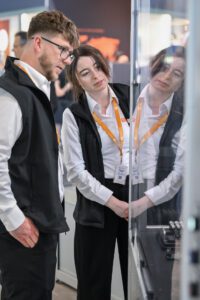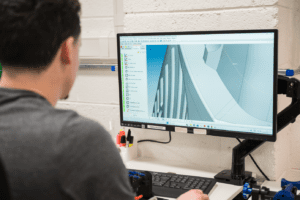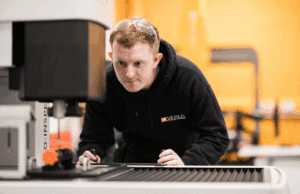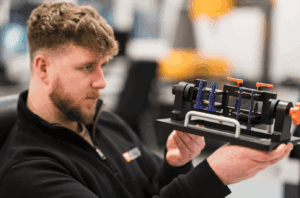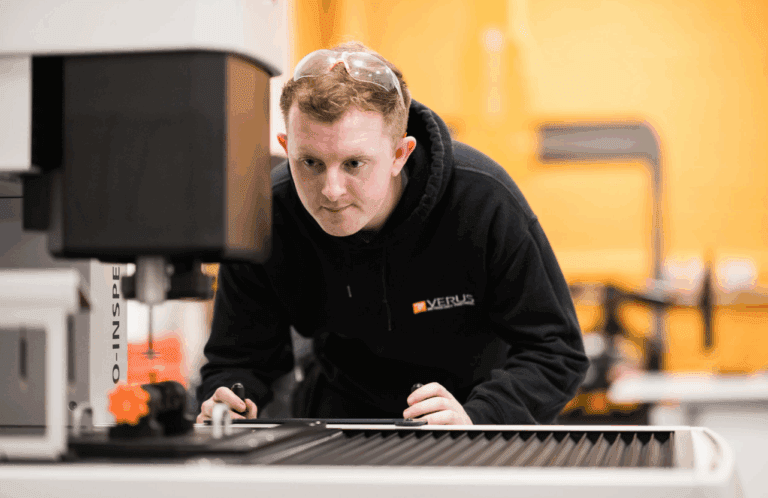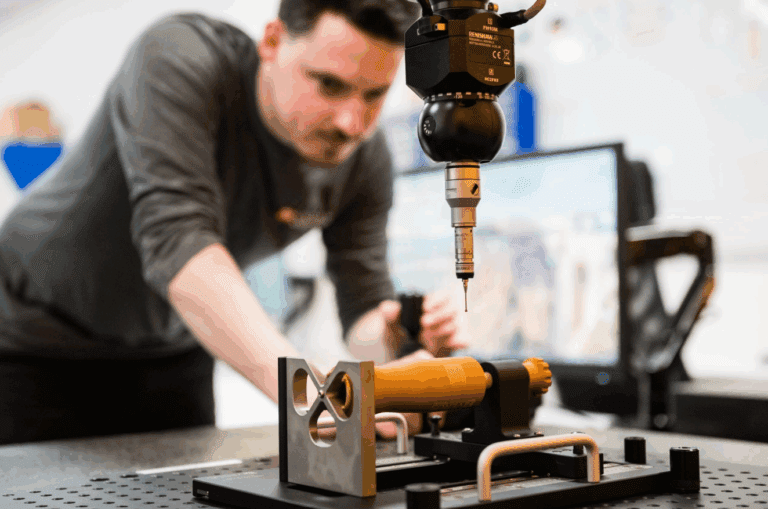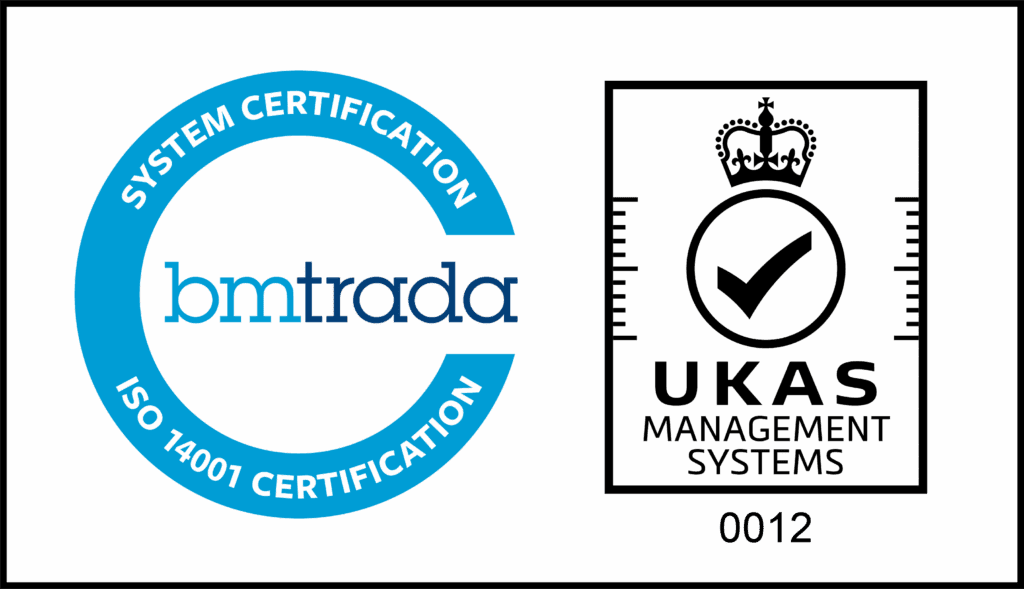In today’s manufacturing landscape, sustainability is no longer optional—it is a strategic and regulatory imperative. Across sectors such as MedTech, Pharmaceuticals, Personal Care, and Aerospace, manufacturers face increasing pressure to reduce their environmental footprint, meet ESG (Environmental, Social and Governance) objectives, and comply with tightening regulations around waste, emissions, and energy use.
One of the most significant contributors to environmental inefficiency in manufacturing is waste, whether in the form of rejected components, excess material usage, or energy consumed during rework processes. Each defective or non-conforming part not only represents a cost burden but also compounds environmental impact through the consumption of raw materials, machine time, and disposal of scrap.
In this context, precision metrology plays a critical but often underappreciated role in sustainability. By enabling accurate, consistent, and repeatable measurement and inspection, metrology ensures that manufactured parts meet exact specifications from the outset. This reduces the likelihood of defects, minimises the need for rework or recalls, and ultimately contributes to more efficient and environmentally responsible production.
Sustainable metrology practices go beyond routine measurement—they form part of a broader quality control strategy aimed at reducing variation, optimising resource usage, and supporting first-time-right manufacturing. Whether through in-line inspection systems, advanced statistical sampling, or subcontract measurement services, these practices are increasingly vital for manufacturers aiming to align production with sustainability goals.
Understanding Sustainable Metrology Practices
Sustainability within manufacturing is often associated with material selection, energy efficiency, and recycling initiatives. However, an equally important contributor lies in how quality is measured and assured. Sustainable metrology practices refer to the application of precision measurement and inspection techniques in ways that minimise waste, reduce variability, and optimise manufacturing processes for both efficiency and environmental responsibility.
At its core, metrology ensures that each component meets defined dimensional and geometric requirements. When applied through a sustainability lens, metrology extends beyond compliance and product performance; it becomes a means of preventing overproduction, scrap, and rework, which are among the most resource-intensive inefficiencies in manufacturing.
Key elements of sustainable metrology practices include:
· First-time-right inspection: By ensuring that parts conform to specification from the earliest stages of production, manufacturers reduce the likelihood of producing large volumes of defective or marginally conforming components.
· Optimised sampling strategies: Instead of relying on exhaustive inspection, advanced statistical approaches enable efficient validation of critical dimensions while limiting energy and time spent on unnecessary measurement.
· High repeatability and reproducibility: Sustainable metrology depends on confidence in results. Reliable measurement data prevents unnecessary corrective action caused by false positives or inconsistent inspection outcomes.
· Traceability of measurements: Traceable data allows for root-cause analysis and continuous process improvement, reducing recurring sources of scrap and supporting regulatory compliance.
These practices contribute directly to leaner, more resource-conscious production. For example, in MedTech, where tolerances can be as tight as a few microns, sustainable metrology practices ensure that components are manufactured accurately the first time, minimising the environmental and financial impact of rejected parts. In high-volume industries such as FMCG, efficient measurement strategies help maintain consistent quality without excessive inspection, balancing throughput with sustainability objectives.
By embedding metrology into sustainability frameworks, manufacturers not only protect product quality but also address broader goals such as reduced carbon emissions, improved yield, and compliance with international environmental standards.
Sources of Waste in Manufacturing and How Metrology Addresses Them
Waste in manufacturing is not limited to the visible pile of rejected components on the production floor. It can take multiple forms, from raw material losses to hidden inefficiencies in time, energy, and labour. For manufacturers operating in highly regulated sectors, these inefficiencies translate not only into higher costs but also into greater environmental impact. Sustainable metrology practices directly target these sources of waste, ensuring that quality control contributes to both compliance and sustainability.
3.1 Material Scrap Due to Dimensional Non-Conformance
One of the most common forms of waste arises when components do not meet dimensional or geometric requirements. Even small deviations from specification can render a part unusable, particularly in MedTech and Aerospace applications where tolerances are critical. Scrap at this stage means wasted material, machining time, and energy. How metrology helps: Early and precise measurement identifies deviations before they
propagate through full production runs, ensuring fewer parts are scrapped at later stages when costs and environmental impact are higher.
3.2 Rework and Energy Waste
Reworking defective parts consumes additional machine time, operator input, and energy. While it may recover some value, it also extends lead times and increases a manufacturer’s carbon footprint. How metrology helps: Accurate, repeatable inspection enables manufacturers to avoid rework by catching deviations early in the process. Advanced fixture design and automated inspection systems also help reduce measurement variability, lowering the risk of unnecessary rework caused by false negatives.
3.3 Batch Failures and Recalls
In regulated industries such as Pharmaceuticals and Medical Devices, a single batch failure or product recall can result in massive waste—scrapped inventory, packaging, and logistics resources—along with reputational and regulatory consequences. How metrology helps: By validating critical dimensions and functional features consistently, metrology reduces the risk of non-conforming batches progressing to final assembly or distribution. This prevents large-scale waste events and supports regulatory compliance.
3.4 Over-Inspection and Inefficient Use of Resources
While under-inspection risks quality failures, over-inspection can itself be a form of waste. Unnecessary measurements consume operator time, metrology equipment capacity, and energy, without proportionate benefits to product quality. How metrology helps: Sustainable metrology practices employ risk-based and statistical sampling strategies to balance quality assurance with efficiency. This ensures critical features are validated with minimal redundancy.
In each case, metrology is not only a safeguard for quality but also a tool for reducing wasted materials, time, and energy. By integrating inspection more strategically into manufacturing workflows, companies can achieve a measurable reduction in both cost and environmental impact.
Sustainable Metrology in Practice: Real-World Examples
The principles of sustainable metrology practices become most evident when applied to the realities of production in regulated industries. Each sector faces unique quality challenges, but the common outcome of effective metrology is the same: less waste, fewer defects, and a more sustainable manufacturing process.
4.1 MedTech: Precision in Injection-Moulded Components
Medical devices often rely on complex injection-moulded components where tolerances can be measured in microns. A slight dimensional deviation can compromise device performance or lead to assembly failures. Traditional approaches that rely on excessive inspection or trial-and-error tool adjustments not only extend lead times but also generate significant scrap. Application of sustainable metrology practices: By using customised metrology fixtures and automated inspection, manufacturers achieve first-time-right validation of parts. This reduces scrap rates, avoids unnecessary mould adjustments, and ensures regulatory compliance with minimal environmental impact.
4.2 Pharmaceuticals and Packaging Integrity
In pharmaceutical production, packaging quality is as critical as the product itself. Seal integrity, blister pack dimensions, and container closure systems all require strict validation. Failures in packaging can lead to batch rejections or recalls, resulting in large volumes of wasted product and packaging materials. Application of sustainable metrology practices: High-precision measurement of sealing features and automated dimensional verification ensure compliance before batches progress to distribution. This prevents resource-heavy rework and helps safeguard both patient safety and sustainability objectives.
4.3 FMCG: High-Volume Production Efficiency
Fast-Moving Consumer Goods (FMCG) are produced at scale, where even a small percentage of rejects can translate into significant waste. For example, a misalignment in moulded caps or bottles may result in thousands of discarded units. Application of sustainable metrology practices: Inline metrology solutions, supported by robust statistical sampling, enable continuous monitoring of production without slowing throughput. This balances high output with quality control while minimising wasted plastic, packaging, and energy.
4.4 Aerospace: Reducing Rework on Critical Assemblies
In Aerospace manufacturing, parts often require costly machining and involve exotic alloys or composites with high embodied energy. Scrap or rework at this level carries not only financial costs but also substantial environmental consequences. Application of sustainable metrology practices: Deploying advanced coordinate measuring machines (CMMs), non-contact scanning, and intelligent fixtures ensures precision in critical dimensions. By validating conformity at each stage, manufacturers reduce the risk of expensive rework or wasted high-value materials.
These examples demonstrate how sustainable metrology practices are adaptable across sectors, from high-volume consumer goods to ultra-precise medical and aerospace components. The consistent outcome is reduced waste, improved process efficiency, and measurable environmental benefits—all achieved by embedding metrology into the manufacturing strategy rather than treating it as an afterthought.
The Role of Metrology Subcontract Services in Driving Sustainability
Not every manufacturer has the in-house capacity, expertise, or equipment required to perform high-precision inspection at scale. Building and maintaining a metrology lab involves significant capital investment, ongoing calibration, and the recruitment of specialist staff. For many organisations, particularly those operating under strict regulatory oversight, this can lead to inspection bottlenecks or reliance on less efficient methods that ultimately generate waste.
Metrology subcontract services provide a sustainable alternative. By outsourcing measurement to a dedicated specialist, manufacturers gain access to advanced technology and expertise without the environmental or financial overheads associated with operating their own facilities.
Key sustainability benefits of subcontract measurement include:
· Reduced Over-Inspection: Subcontract providers apply optimised inspection strategies that balance accuracy with efficiency, ensuring only critical features are measured. This avoids unnecessary machine use and operator time.
· Access to Advanced Equipment: High-precision CMMs, non-contact scanners, and bespoke fixtures are available without the need for manufacturers to purchase and maintain them in-house. This reduces duplicated capital equipment across multiple sites and promotes more efficient resource use.
· Expert Data Interpretation: Subcontract engineers provide accurate, traceable results that reduce the risk of misinterpretation and the waste that results from false positives or negatives.
· Scalable Capacity: Outsourcing provides flexible inspection capacity that can be scaled to meet project demand, avoiding underutilisation of equipment or staff during low-volume periods.
For sustainability-focused manufacturers, subcontract services offer an effective way to align inspection with lean production strategies. By eliminating inefficiencies and ensuring only compliant parts move forward in the process, subcontract metrology reduces the risk of scrap, rework, and large-scale recalls.
For more information on how outsourced measurement solutions can strengthen both quality and sustainability strategies, visit our page on Metrology Subcontract Services.
Metrology’s Contribution to Circular Manufacturing and Net Zero Goals
As manufacturers transition towards circular economy models and commit to Net Zero targets, the role of quality assurance is expanding beyond compliance. Precision measurement is increasingly recognised as an enabler of resource efficiency, closed-loop manufacturing, and carbon reduction strategies. Sustainable metrology practices form a vital link between engineering accuracy and environmental responsibility.
6.1 Enabling Lean and Circular Manufacturing
Circular manufacturing aims to design out waste, keep products in use for longer, and regenerate natural systems. For this model to work, components must be manufactured to consistently high standards so they can be reused, repaired, or remanufactured without excessive rework. Contribution of metrology: By ensuring dimensional accuracy and traceability throughout the product lifecycle, metrology reduces premature product failures and supports reuse or remanufacture, key pillars of a circular system.
6.2 Reducing Overproduction and Energy Use
Overproduction is a major driver of industrial waste and unnecessary carbon emissions. Manufacturing more parts than required—or producing excessive scrap due to quality issues—consumes raw materials and energy that could otherwise be avoided. Contribution of metrology: Inline and automated inspection systems provide real-time feedback, allowing manufacturers to correct deviations before large volumes of material are wasted. This results in more efficient energy and material use across production.
6.3 Supporting Net Zero Reporting and ESG Metrics
Achieving Net Zero requires accurate measurement not only of emissions but also of operational efficiency indicators such as scrap rates, rework levels, and production yield. Metrology data provides a reliable foundation for these metrics. Contribution of metrology: Traceable inspection records can be integrated into sustainability reporting frameworks, demonstrating quantifiable reductions in waste and providing evidence of environmental improvement to regulators and stakeholders.
6.4 Enhancing Product Longevity
Products that conform precisely to specification tend to perform better and last longer. In sectors such as Aerospace and MedTech, longevity translates directly into fewer replacements, less waste, and reduced overall environmental impact. Contribution of metrology: By validating tight tolerances and ensuring long-term component reliability, metrology helps extend product lifecycles and reduces resource consumption.
In these ways, metrology is not simply a quality assurance tool—it is a strategic enabler of sustainable manufacturing. By embedding accurate, data-driven measurement into the production process, companies can make meaningful progress towards circularity and Net Zero goals.
Future Trends in Sustainable Metrology
Sustainable metrology practices are not static; they continue to evolve in line with technological advances and growing sustainability demands. As manufacturing industries pursue higher efficiency and lower environmental impact, several key trends are shaping the future of metrology.
7.1 Automation and Inline Measurement
Automation is transforming inspection from an isolated, end-of-line process into an integrated part of production. Inline measurement systems deliver real-time data, reducing the need for offline checks and preventing waste by catching defects immediately. Sustainability impact: Less scrap, faster feedback loops, and lower energy use from rework cycles.
7.2 Digital Twins and Closed-Loop Control
The integration of metrology data into digital twins enables manufacturers to simulate, predict, and optimise production processes with high accuracy. Closed-loop systems then adjust machining or moulding operations automatically based on inspection feedback. Sustainability impact: Reduces trial-and-error adjustments, material waste, and unnecessary machine operation.
7.3 Intelligent Fixtures and Smart Metrology Systems
Advances in fixture design, including modular and automated fixtures, are reducing setup times and operator intervention. Intelligent systems use embedded sensors to monitor conditions and optimise measurement efficiency. Sustainability impact: Faster, more accurate inspections minimise downtime and resource consumption.
7.4 Non-Contact and Multi-Sensor Measurement
Optical scanning, computed tomography (CT), and hybrid systems allow complex geometries to be measured without physical contact. These methods capture more data per cycle, often in less time, compared to traditional approaches. Sustainability impact: Higher throughput reduces energy use per inspection and provides richer datasets for process optimisation.
7.5 Integration with Sustainability Reporting Tools
As ESG reporting becomes standard across industries, inspection data will increasingly be linked to environmental metrics such as scrap reduction, yield improvement, and energy efficiency. Sustainability impact: Creates traceable evidence of environmental performance improvements for audits and stakeholder reporting.
These emerging trends highlight a shift in mindset: metrology is no longer seen as a cost centre or bottleneck but as a driver of sustainable value. By embracing automation, digitalisation, and intelligent systems, manufacturers can align quality assurance with long-term environmental and business objectives.
Making the Case for Metrology as a Sustainability Enabler
Sustainability in manufacturing is often viewed through the lens of material innovation, renewable energy, or supply chain efficiency. Yet the role of precision measurement is just as critical. Sustainable metrology practices provide the foundation for waste reduction by ensuring that every part produced is right the first time, every time.
Across industries such as MedTech, Pharmaceuticals, FMCG, and Aerospace, accurate inspection prevents scrap, minimises rework, and avoids large-scale recalls. By embedding metrology into production strategies, manufacturers can achieve measurable environmental benefits alongside operational efficiency. Outsourced solutions such as subcontract measurement services extend this capability further, enabling companies to access advanced inspection technology without duplicating resources or infrastructure.
Looking ahead, advances in automation, digital twins, and intelligent fixtures will make metrology an even more powerful driver of sustainable manufacturing. These innovations will allow inspection data to be integrated directly into circular economy strategies, Net Zero initiatives, and ESG reporting frameworks.
In practical terms, investing in sustainable metrology practices is not only a pathway to regulatory compliance and cost efficiency but also a tangible contribution to global sustainability goals. For manufacturers seeking to reduce environmental impact while safeguarding quality and reliability, metrology is not an optional process—it is a strategic enabler of long-term success.
